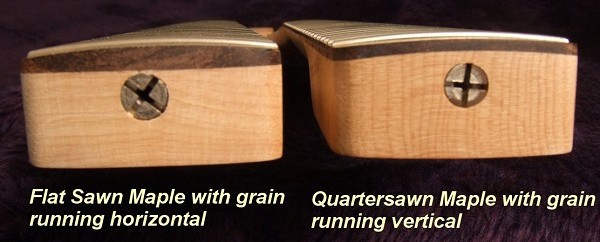Hands down, the Fender Stratocaster® is the world’s most popular guitar, and has spawned probably hundreds of copies. Being also designed by Leo Fender, the G&L Legacy is what we can assume to be the evolution of the Strat: Improved floating bridge, updated tone controls, and slightly fatter pickups (compared to a vintage style Fender anyway). The Legacy looks and feels a lot like a Strat, but the tonality of the bridge, slightly beefier neck and the pickups gives it the G&L vibe. Plus you can pretty much spec out your own G&L, but that’s for another day.
The “other” Legacy — the S-500 — often gets left out of the conversation. With it’s G&L Magnetic Field Design (MFD) pickups, the S-500 has slightly different, more industrial look. And while rock ‘n roll is supposed to be the music of rebellion, guitarists can be very conservative, and things that deviate from “vintage” often get rejected. With the exposed socket head pole pieces of the S-500 pickups, the guitar looks just different enough to get passed over by some players as “not right.”
But is the S-500 a better guitar?
Possibly “better” is the wrong word choice, but the S-500 is possibly a more useful guitar in the context of playing and performing. It’s in the best commercial interests of G&L to produce something that is essentially akin to a Stratocaster. While I can’t say for certain, it’s probably G&L’s best selling model too (though I sell more ASAT’s than Legacy’s). But the G&L MFD pickup is intended to be an improvement over the conventional Alnico pickups designs, and in theory the S-500 is supposed to be an evolutionary step forward.
The basic concept behind the MFD pickup is that it’s really built more like a P-90, with a ceramic bar magnet underneath, and with six adjustable steel pole pieces. The MFD pickups also have a fairly low coil resistance, but a stronger, broader magnetic field. The low coil resistance results in a more even frequency response, but the magnetic field creates a greater signal output. The result is a fairly “hot” single coil with a full frequency response, and none of the peaks and hot spots characteristic of an over-wound conventional pickup.
Sound Comparison
The overall sound of an S-500 versus a Legacy is that it’s a little fatter and warmer. The tone is slightly darker, there is less midrange scoop, and they are not as glassy and bright on the top end. Sounds terrible doesn’t it? Well not really, especially given the fact that nearly all rock music these days is played with some amount of overdrive or distortion. The greater midrange, output and lack of icy top end of the S-500 makes it a great choice for more modern sounds. Overdrive tones with the S-500 are rich, harmonic, and much fuller than than a guitar with conventional pickups. The bridge pickup is absolutely more useable than a Strat bridge pickup, and the in-between tones of the neck + middle and middle + bridge are also punchier and less brittle. The higher output and slightly attenuated high end works great with pedals too.
In the context of playing live, the S-500 holds up very well, and can be heard in the mix without getting shrill or piercing. The extra heft of the MFD pickups and their fuller, creamier overdrive tones project very well, and fit many styles of music from classic rock to progressive. Bedroom tone and live tone are very different animals, and while the S-500 may lack some of the glassy cleans of a Legacy, it’s a great tool for covering a wide range of musical styles.
I will reference a story that has been told several times in different publications: Jimi Hendrix was known for using a long, cheap Radio Shack coil cable with his Strat. Coil cables are notorious for having a lot of electrical capacitance, which cut high frequencies, boosts the midrange, and makes the tone darker. The net effect of Strat + Coil cable is a warmer, darker Strat with less high end.
Blues legend Buddy Guy has often performed live with a Stratocaster equipped with Fender Lace pickups. These are noiseless dual coil (humbucking) designs that sound very clean but have a lot body and output. For years Clapton Strats have used active EQ and noiseless (humbucking) pickups. While I hesitate to drop names like these in this lowly blog, they are good examples of true guitar heroes that don’t always adhere to tradition and pure vintage setups.
Cheap Advice
If general jamming, low volume playing, or traditional blues, funk and rock tones are your bag, the G&L Legacy is great choice. You’ll hear the sound you hear on the records. And as there is a plethora of aftermarket pickups that will drop right in, you’ve got huge leeway to experiment. If you really like to rock and can deal with the look, go for a Legacy HB with the bridge humbucker.
If you tend to play out, use effects, and cover a wide range of music (such as a cover band) the S-500 is worth serious consideration. While it can’t cop the pure scooped glassy tone of a Strat or Legacy, it’s still single coil in nature, but can morph in many different directions with ease. You can experiment and mix MFD pickups with conventional pickups, but visually the guitar may look a little mongrel. Personally, MFD’s respond differently than conventional pickups, and I don’t mix them.
The S-500 is meant to be in some ways a “better” guitar, and depending on what your needs are, it really is.
For guitar offerings at Upfront Guitars: www.upfrontguitars.com


